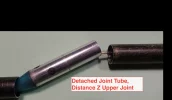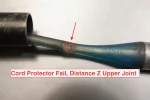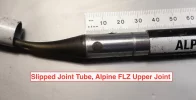I was able to do some walking in Galicia recently, and was happy to have my Black Diamond Z-poles with me. HOWEVER

, at some point I messed one of them up. Hope I can explain this, but what I now see when one of my poles is collapsed is that one of the joints just shows a cord. That is, the blue rubber covering has disappeared, and I don't see the same mechanism as I see at other the joints of the pole.
If this makes sense, and if anyone has any great repair ideas (I'm hours from an REI or good outdoor store), let me know. Thanks, Buen camino, Laurie
I was able to do some walking in Galicia recently, and was happy to have my Black Diamond Z-poles with me. HOWEVER

, at some point I messed one of them up. Hope I can explain this, but what I now see when one of my poles is collapsed is that one of the joints just shows a cord. That is, the blue rubber covering has disappeared, and I don't see the same mechanism as I see at other the joints of the pole.
If this makes sense, and if anyone has any great repair ideas (I'm hours from an REI or good outdoor store), let me know. Thanks, Buen camino, Laurie
My wife and I have this problem with both pairs or our Z-Poles, her's came all the way out and mine are starting to. The problem and fix are what you were told by the manufacturer. This joint has disassembled itself and must be retrieved from the upper section it slid into and put back and glued into the lower section to function properly, it has nothing to do with cord tension adjustment or the snap button.
The Z-joint consists of a 50mm (~ 2in) long inner aluminum tube that the manufacturer inserted half way into the upper end of the section below the joint and glued in place, leaving the other half (25mm) sticking out - this is the shiny smaller diameter tube you see projecting from the lower section of a non-failed joint when the poles are folded. The flexible, rubbery sleeve that protects the cord from being cut by the sharp edges of the folded tubes is fixed in place in the upward facing end of the small tube and slides into the section above when the poles are assembled. The joint gets its lateral stiffness (resistance to bending) from the overlap of this inner joint tube with the two outer tubes, to do its job effectively it must be insert about equally into the tubes on either side of the joint.
With use the the glue holding this joint tube in place fails, allowing the joint tube to work itself out of the lower tube and, in both the poster's case as well as my wife's, it slid all the way up into the next higher section. Black Diamond suggests extracting it from the upper section using a small screwdriver, we managed it using the handle end of a metalworking file which generally have sharp edges that can grab the inside edge of the joint tube for twisting as one pulls.
Before gluing, clean the surfaces to be bonded with an oil-free solvent, rubbing alcohol or methanol should do, and you may want to rough up the bonding surfaces with medium emery paper followed by another alcohol wipe - many glues don't bond well to metals and benefit from some mechanical interlocking (it appears Black Diamond failed to do this). You want to both degrease the joint and remove traces of the original adhesive from both the joint tube and the lower section that it will be glued back into. It looked like the original adhesive on my wife's may have been a type of superglue - we used a thin bladed knife to scrape it out (the end of a file or any sharp tool should do), follow this with emery paper wrapped around a pencil or dowel, then an alcohol moistened cloth or cotton wrapped around a dowel.
You can try superglue, but a compliant (not brittle) structural adhesive may be a better choice for resisting the repetitive flexing these joints receive - my favorite is 3M's type 2216, ask around. The epoxy "JB-Weld" also should work. Thick epoxies generally can be thinned with alcohol but other types of glues may require different thinners. After the joint tube is back in place, wipe off any glue residue from the joint before it sets - an alcohol moistened rag will work for epoxies. To be on the safe side, wait for the glue to set before reassembling the pole.
Another problem we've had is cutting of the protective sleeve by the tube edges. BD says these can't be replaced, but suggests that superglue, applied to a developing cut, may extend their life. Gluing on a patch of tough material (urethane rubber, leather, etc., or wrapping with cloth "friction tape" also may help. Inspection is your friend.
 , at some point I messed one of them up. Hope I can explain this, but what I now see when one of my poles is collapsed is that one of the joints just shows a cord. That is, the blue rubber covering has disappeared, and I don't see the same mechanism as I see at other the joints of the pole.
, at some point I messed one of them up. Hope I can explain this, but what I now see when one of my poles is collapsed is that one of the joints just shows a cord. That is, the blue rubber covering has disappeared, and I don't see the same mechanism as I see at other the joints of the pole. 



















